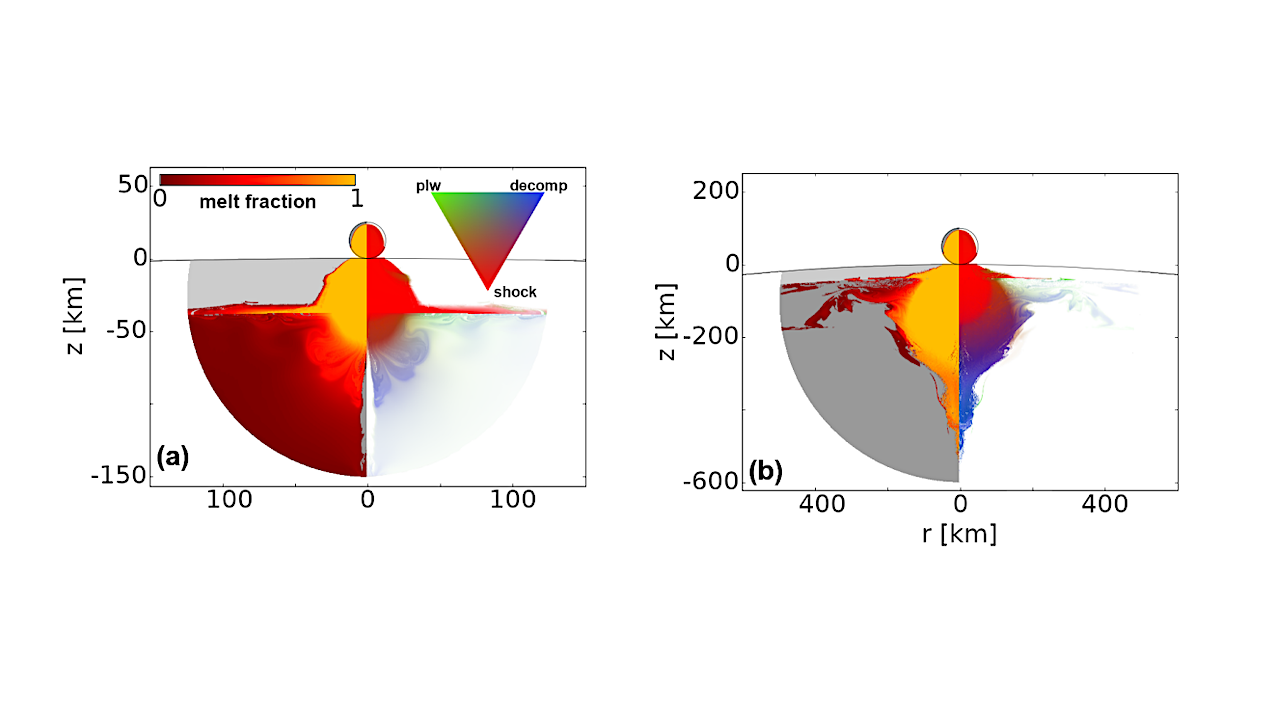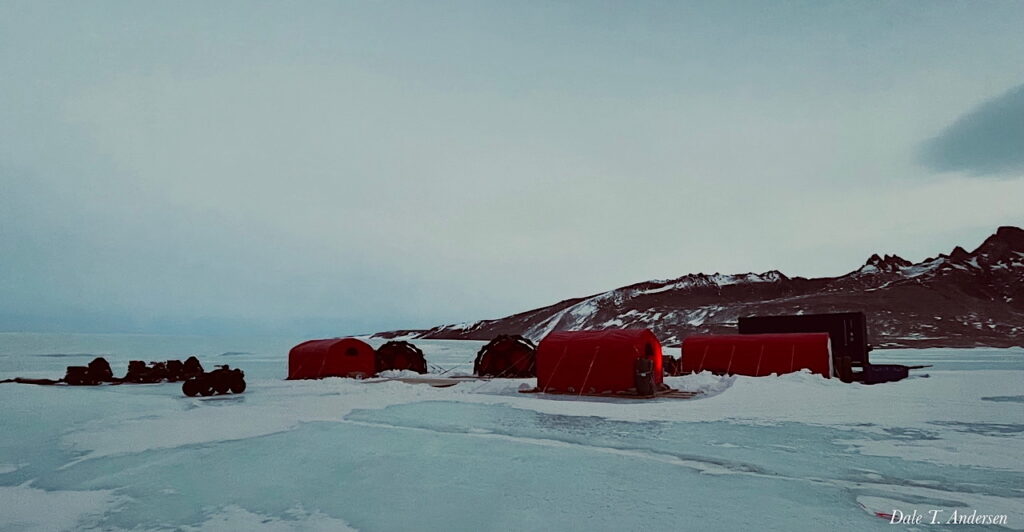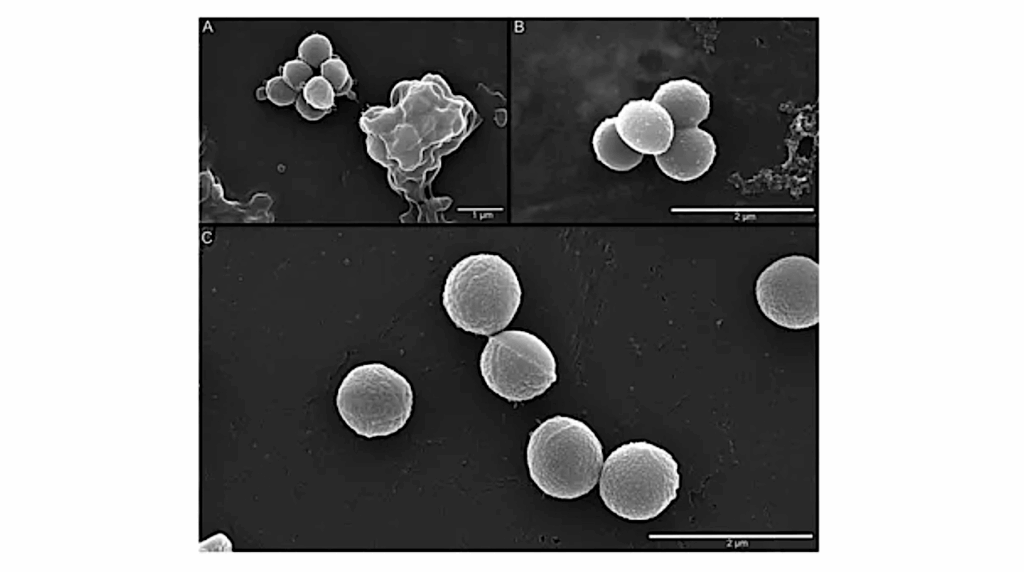Now Reading: The Influence Of Interior Structure And Thermal State On Impact Melt Generation Upon Large Impacts Onto Terrestrial Planets
-
01
The Influence Of Interior Structure And Thermal State On Impact Melt Generation Upon Large Impacts Onto Terrestrial Planets
The Influence Of Interior Structure And Thermal State On Impact Melt Generation Upon Large Impacts Onto Terrestrial Planets


Impact on a 3 Gyr-old Earth-sized planet with a small core Rc = 0.2R and L = 25 km (a) and 100 km (b). In each panel, the left half displays the melt fraction and the right half the melting mechanism, with the materials shown at their pre-impact positions. Basaltic crust is shown in light gray and dunitic mantle material in medium-shaded gray. The melt generation farther than 5L from the center of the melt region below the impact point (approximated by z = L) is neglected. — astro-ph.EP
We investigate the melt production of planetary impacts as a function of planet size (R/REarth=0.1-1.5), impactor size (L=1-1000 km), and core size ratio (Rcore/R=0.2-0.8) using a combination of parameterized convection models and fully dynamical 2D impact simulations.
To this end, we introduce a new method to determine impact-induced melt volumes which we normalize by the impactor volume for better comparability. We find that this normalized melt production, or melting efficiency, is enhanced for large planets when struck by smaller impactors, while for small planets, melting efficiency is elevated when impacted by larger impactors.
This diverging behavior can be explained by the thickness of the planets’ thermal boundary layer and the shapes of their thermal and lithostatic pressure profiles. We also find that melting efficiency maxima are usually highest on Earth-size planets. We show that the melting efficiency is only affected by core size ratio for large cores and older planets, where melt production is decreased significantly compared to smaller core size ratios.
Projecting the lunar impactor flux on the generic planets, we find that Moon-sized planets produce the most melt throughout their evolution, relative to planet volume. Contrary to previous scaling laws, our method accounts for melt production by decompression or plastic work in addition to shock melting.
We find that traditional scaling laws underestimate melt production on length scales where variations in the target planets’ lithology, temperature, and lithostatic pressure become significant. We propose empirical formulas to predict melt generation as a function of radial structure and thermal age.
Lukas Manske, Thomas Ruedas, Ana-Catalina Plesa, Philipp Baumeister, Nicola Tosi, Natalia Artemieva, Kai Wünnemann
Comments: 32 pages, 14 figures
Subjects: Earth and Planetary Astrophysics (astro-ph.EP); Geophysics (physics.geo-ph)
Report number: TRR 170 contribution 225
Cite as: arXiv:2506.18718 [astro-ph.EP] (or arXiv:2506.18718v1 [astro-ph.EP] for this version)
https://doi.org/10.48550/arXiv.2506.18718
Focus to learn more
Journal reference: J. Geophys. Res., 130 (2025)
Related DOI:
https://doi.org/10.1029/2024JE008481
Focus to learn more
Submission history
From: Thomas Ruedas
[v1] Mon, 23 Jun 2025 14:54:12 UTC (2,053 KB)
https://arxiv.org/abs/2506.18718
Astrobiology
Stay Informed With the Latest & Most Important News
Previous Post
Next Post
Previous Post
Next Post
-
 012024 in Review: Highlights from NASA in Silicon Valley
012024 in Review: Highlights from NASA in Silicon Valley -
 02Panasonic Leica Summilux DG 15mm f/1.7 ASPH review
02Panasonic Leica Summilux DG 15mm f/1.7 ASPH review -
 03How New NASA, India Earth Satellite NISAR Will See Earth
03How New NASA, India Earth Satellite NISAR Will See Earth -
 04And Thus Begins A New Year For Life On Earth
04And Thus Begins A New Year For Life On Earth -
 05Astronomy Activation Ambassadors: A New Era
05Astronomy Activation Ambassadors: A New Era -
06SpaceX launch surge helps set new global launch record in 2024
-
 07Space Force plans new ‘Futures Command’ amid pressure to speed up modernization
07Space Force plans new ‘Futures Command’ amid pressure to speed up modernization


















